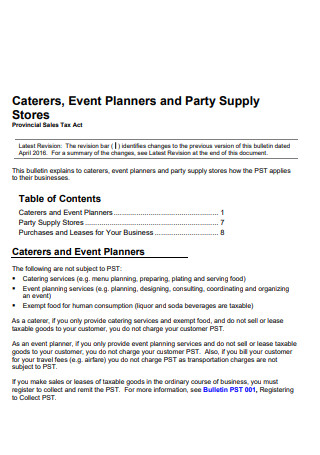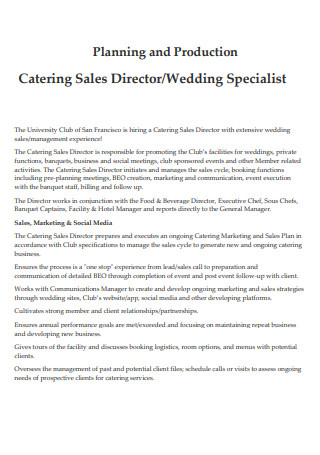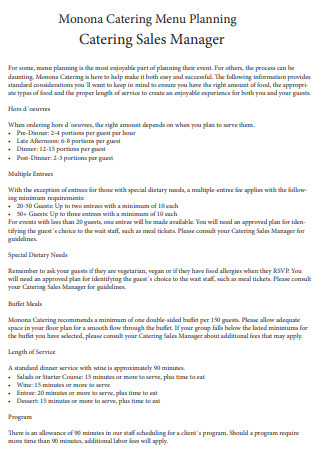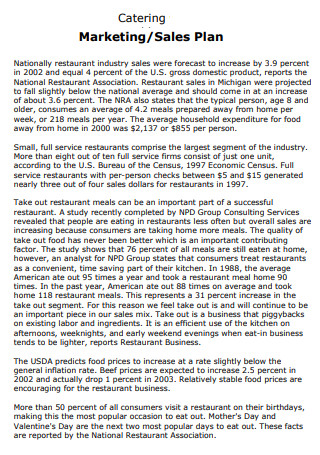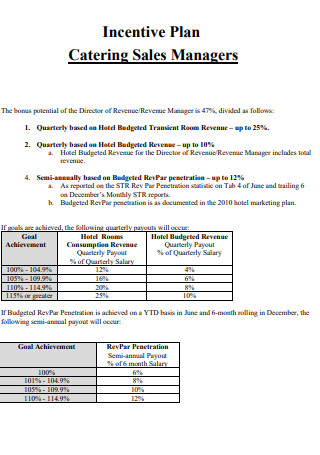4+ SAMPLE Catering Sales Plan
FREE Catering Sales Plan s to Download
4+ SAMPLE Catering Sales Plan
What IS a Catering Sales Plan?
4 Common Functions in Catering
How to Make a Catering Sales Plan
FAQs
What are some of the common types of catering?
What are some of the food preparation techniques?
What are some of the well-known cuisines?
What IS a Catering Sales Plan?
A Catering Sales Plan lays out the targets or goals, including the strategies and tactics needed to meet those goals. A sales plan target is usually in the form of sales revenue. It is often used as a report to present to potential investors or lending institutions to help fund the business. Sales planning should follow the SMART goals method. Plans should be Specific, Measurable, Achievable, Relevant, and Time-bound. A typical catering sales plan target includes a time-bound revenue target and a target of increasing customer reach or customer patronage. Catering can come in two forms: off-premise or on-premise catering. Off-premise catering is a catering service performed where the food cooking and preparation happens on a different location and is then delivered and ready to serve in the location where customers are set up to eat. On-premise catering is the food cooking and preparation that is being made at the same location where customers are supposed to dine at. These two forms of catering usually depend on the customer requirements, or sometimes on how feasible the venue is for the catering service. That’s why being flexible is important when having a catering business. If additional funds are needed to be able to do both on-premise and off-premise catering, then that’s when the catering sales plan should be meticulous and carefully planned out.
4 Common Functions in Catering
Food is the first thing people think of when they hear or see the word catering. Food cooking, food preparation, or food presentation. Of course, there’s more to catering than just coming up with the menu and groceries. Catering is akin to organizing. It takes a lot of people to help get the business up and going – unless you have some sort of superhero with the superpower to multitask and take on the whole operation all by yourself! More than just putting on a chef’s hat or a business suit, you need to know the ropes of catering. To effectively run the catering business, you need to be familiar with these important functions.
How to Make a Catering Sales Plan
A catering sales plan is just like a roadmap. It’s a guide that contains strategies and tactics to help the catering business achieve its sales goals. The sales goal usually comes in the form of sales revenue, but it could also be in the form of sales in terms of quantity or the number of clients or businesses that were converted into closed sales. Sales planning should be flexible enough to meet the business’s needs, operational, or sales requirements since all businesses’ needs are unique. Because of this, there is no strict format to follow when creating a catering sales plan. To be effective though, a sales plan needs to have the following essential elements.
-
1. Executive Summary
A catering sales plan executive summary contains a brief background about the catering business. It briefly explains the catering business’s sales goals and objectives and what are the steps to go about achieving those goals. The executive summary also briefly describes the services offered by the catering business, including its management or organizational structure. Executive summaries often contain a mission and vision statement. A mission statement states the purpose of having a sales plan. It also reflects the catering business’s culture and values. Canada’s Elizabethan Catering Services has a good example of a mission statement. A few lines of their mission statement go: “To provide exceptional value to our customers, using the best and freshest ingredients, superb service staff and equipment. To strive to be the leader in the Catering Business, by constantly striving to be the best at what we do, and by searching for ways to improve.” A vision statement explains what the catering business hopes to achieve in sales, usually within a given timeframe. It serves as a motivation, a call to action for the business’s owner and employees to work together in accomplishing the business’s sales goals. Impressions Catering, a leading Australian catering business, has a vision statement that goes: “To be a leading provider of quality delicious foods and impeccable customer service by offering a versatile and flexible service with consistency and presentation that will leave a lasting Impression. To build an outstanding reputation that we exceed in every service through our dedicated to the success of our customers’ important occasions and creating memorable events.”
-
2. Market Analysis
A market analysis of a sales plan looks into the condition of the market, including its target customer market, as well as its existing competitors’ profiles. For a catering business, its target market is very diverse and very broad. It can be of any group of people, of all ages, of all lifestyles, et cetera. If needed, checking the customer target market can be done by doing a demographics classification, which is done by classifying customer groups into age, gender, income, lifestyle, culture, affiliations, et cetera. The market analysis also checks if there is a niche in the market for the particular catering business that you offer. It considers the size of the market, the current market trends, customer patterns when hiring catering services, including the regulations and barriers to entry factors. A SWOT analysis can also be performed when studying the market. SWOT stands for Strengths, Weaknesses, Opportunities, and Threats. The strengths of the catering business are what made it stand out from the competition. It could be in the form of unique food specialty or preparation that they offer, their added-value services, or their innovative marketing strategies. Weaknesses are those aspects of the catering business that need improvement, or those aspects that are limiting the success of the catering business in terms of sales goals. It could be in the form of lack of funding, lack of manpower, or lack of equipment needed to run the catering service. Opportunities are those features that the business can leverage to boost its chances of successfully achieving its sales goals. These opportunities could be using the current advertising trend of social media or social networking platforms to increase customers or clients base or using influencers to promote the catering business. Threats are those factors that could potentially harm the catering business. The threats could be the increasing presence of competition, lack of investors, and/or strict local business or licensing requirements.
-
3. Marketing and Sales Strategies
The marketing and sales strategies should be anchored on the goals and objectives of the sales plan. A marketing strategy is all about reaching out to potential customers and converting them into actual buying customers. A sales strategy is all about how you position the product in the market. It’s about creating a need within the target market. It’s also about how your sales team can reach their sales quota. An example of a marketing strategy for a catering business is to build an online presence by creating a website, or leveraging social media or social networking sites to increase the market’s awareness about the services that you offer. Aside from creating an online presence, SEO marketing is also another strategy that you can utilize. SEO, or search engine optimization, is about ranking the website to be on top of every keyword search on catering. Making sure that you have a good, trained team answering customer queries and monitoring customer reviews and testimonies through your online media is also another marketing strategy. Sales strategy is product positioning. An example of a catering sales strategy is to host free tasting events. This will allow potential customers to get a taste of the kinds of menu or dishes that you will be serving. Referral or cross-promoting is also another sales strategy. Catering often works together with photographers, florists, event planners, et cetera. During these events, you can hand out brochures as a way of promoting your business. Or, you could have the other groups such as the event planners to promote your business along with theirs, and you could do the same for these groups as well when you’re promoting your own business.
-
4. Financial Plan
The financial plan section in a sales plan describes the current financial condition of the catering business. This is the section that is reviewed by potential investors or by lending institutions to check on how financially stable the catering business is and how feasible and measurable are the strategies to be able to achieve the business’s sales goals. The financial plan section oftentimes contains a cash flow statement, a balance sheet, and a financial projection. Cash flow reflects the capital versus the expenditure. The balance sheet includes the assets versus the liabilities. The financial projection is a financial estimate of where the business is heading in terms of profit or revenue based on capital, expenses, and the projections coming from the marketing and sales strategies.
FAQs
What are some of the common types of catering?
The three common types of catering are delivery catering, full-service catering, and/or restaurant or hotel catering. Delivery catering mostly involves food packs preparation, or meals prepared in a separate location and transported to a different location. Full-service catering is when caterers are hired to have meals cooked, prepared, and served in the same location. Restaurant or hotel catering is usually caterers internally hired or retained by a hotel.
What are some of the food preparation techniques?
Food preparation is what they usually call the art and science of food making. It includes the manner of styling, decorating, and cooking dishes. Some of the food preparation techniques are frying, baking, broiling, roasting, microwaving, and mechanical and chemical techniques. Mechanical techniques include cutting, kneading, mixing, milling, basting, et cetera. Chemical techniques are marinating, fermenting, seasoning, salting, souring, sugaring, brining, and so on.
What are some of the well-known cuisines?
A cuisine is a unique cooking style or method characteristic of a certain region, country, or establishment. Some of the international known cuisines are the Asian cuisines which include the Chinese, Japanese, Korean, Indian, or Thai cuisines; European cuisines, which are the Mediterranean, French, Italian, and English cuisines; African cuisine, the Mediterranean or Ethiopian cuisine; or the Latin American cuisine, which are your Mexican and South American cuisines.
Catering is a necessity in any kind of function or event. Good catering can turn any event around. If things are not going well in an event, having good food will be the event’s redemption, a turning point to make the event a successful one. Having good, delicious food is just but one part of a catering business. A lot of work has to be put in to make a catering service successful. And a catering sales plan is a good tool to use to run a catering business.
Need help in achieving your catering business’s sales goals? Look no further! Download our catering sales plan templates now, and start making your way towards achieving that successful catering business service!

